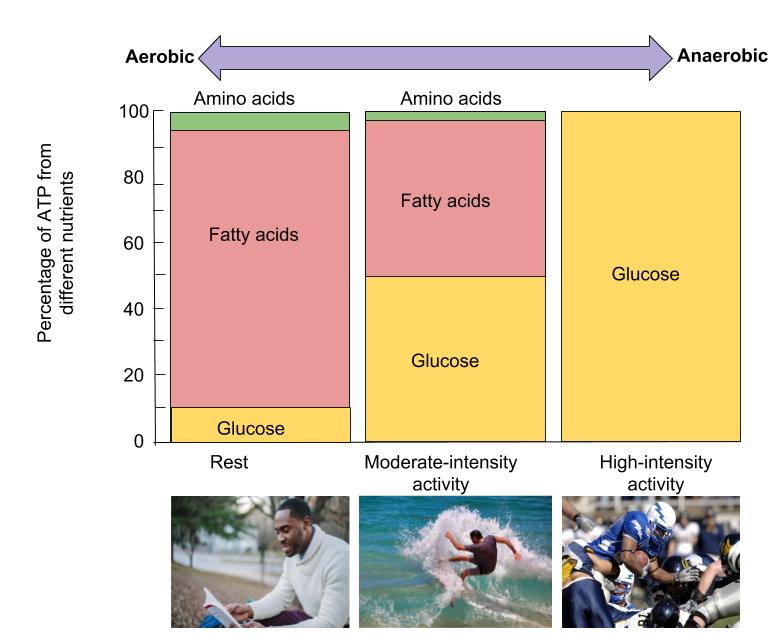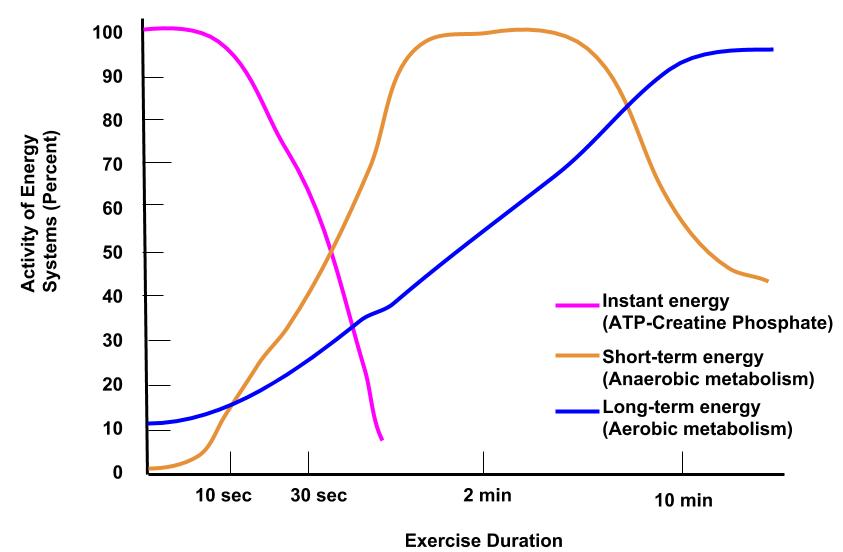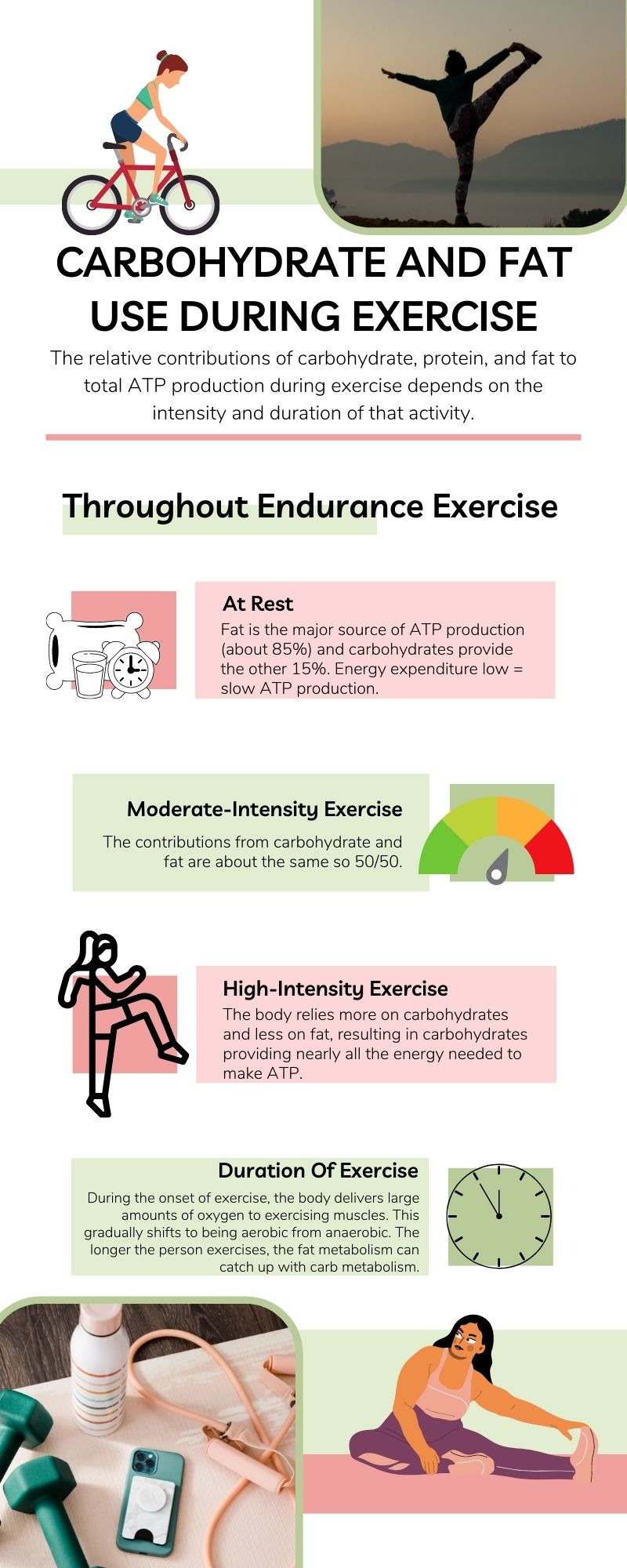8.6 Exercise Intensity and Fuel Use
Carbohydrate Intake and the Use of Protein for Energy
The major dietary factor that will increase the use of protein as an energy source is a low carbohydrate intake. When dietary carbohydrate is insufficient, the body must obtain its carbohydrate from somewhere. If you recall from chapter 5, glucose is critical for brain and nervous system function. So, if glucose intake is lower than what is needed to provide energy for the brain and nervous system (including the brain), the body must create glucose from non-carbohydrate sources to make up the deficit. It does this by breaking down amino acids from body proteins, primarily muscle, and converting it into glucose in the liver through the process of gluconeogenesis. The glucose can then be used to support physiological functions. For the athlete, this is extremely detrimental because it comes at the cost of muscle tissue. If carbohydrate intake is adequate for the athletes training needs and maintenance of glycogen stores, then muscle tissue will not need to be broken down for glucose production. Hence, carbohydrate spares protein.
Fuel Mix: Carbohydrate and Fat Use During Endurance Exercise
The predominant energy system and relative contributions of carbohydrate, protein, and fat to total ATP production during exercise is determined by the intensity and duration of the activity. Since protein is a relatively insignificant contributor to overall energy needs, this section will focus on the contributions of carbohydrate and fat to ATP production.
At rest, fat is the major source of ATP production, contributing approximately 85% to total energy production, and carbohydrate providing the other 15%. When at rest, energy expenditure is consistent and relatively low so ATP does not need to be produced quickly. There is also sufficient time for the respiratory and cardiovascular systems to supply the muscles with oxygen and lipolysis/beta-oxidation to take place. As activity increases, energy requirements increase and the body requires a faster source of ATP. This leads towards a shift towards carbohydrate because glycolysis is faster than lipolysis and beta-oxidation. During moderate-intensity exercise, the contributions from carbohydrate and fat are roughly equal (50/50). As intensity increases above moderate levels, the contribution from carbohydrate increases and it becomes the predominant fuel source. During high-intensity activities, carbohydrate provides nearly all the fuel needed to make ATP because it is the fastest most immediate source of energy and can provide ATP both aerobically and anaerobically.
Figure 8.13 Fuel Use During Exercise

Both fuel use and contribution from the energy systems changes with the duration of the exercise. During the first few moments of exercise, the muscles are the first to respond to the change in activity level. The respiratory and cardiovascular systems however take longer to react and though you may experience an increase in breathing rate and increased heart rate, it takes time to actually increase oxygen delivery to the working muscles. In order for the body to get the energy that is needed, the ATP-CP system predominates as the immediate source of ATP while glycolysis ramps up. After about 10 seconds, the stored CP in the muscle cells is depleted and the ATP-CP system slows down. At this point, the respiratory and cardiovascular systems have still not adapted to the increased oxygen demands of exercise so glycolysis takes over while the body waits for aerobic metabolism to ramp up. After 2-3 minutes, the respiratory and cardiovascular systems have had enough time to deliver oxygen to the exercising muscles and aerobic metabolism (Krebs/ETC) takes over. Aerobic metabolism is the most efficient way of producing ATP and will continue to predominate as long as there is a fuel source and sufficient oxygen. Figure 8.14 shows how energy is supplied in a smooth continuum as the body shifts from one energy system to another.
Figure 8.14 Exercise Duration and Relative Contribution of Energy Systems

Another important consideration is that fat mobilization and oxidation are slow complex processes that take time. Because of this, there is a “lag time” between the onset of exercise and the point at which fat becomes a major contributor to energy production. Depending on several factors, there can be a 10–20 min period of time after the onset of exercise until fat metabolism can catch up with carbohydrate metabolism. The training status of the athlete also has an effect on fuel mix. Highly trained endurance athletes metabolize fat more efficiently and to a greater degree, and rely less on carbohydrate as a source of fuel. The “lag time” for fat metabolism at the beginning of exercise is also shorter for people who have higher levels of aerobic fitness. Fit people are fat burners; unfit people are sugar burners.
Some endurance activities require relatively consistent intensities and are referred to as “steady state” activities. For example, you may do a 5-mile run and remain at an 8 min/mile for the majority of the time. During steady state endurance exercise, aerobic metabolism will be the predominating source of energy production almost the whole time, and the relative fuel contributions will remain steady as well. But what if you decided to do some interval training during your run? For example, after you warm up, you decide to do 1-min intervals of sprinting alternated with 3 min of jogging. What happens to the energy systems and fuel mix during the intervals of sprinting? During the jogging (moderate intensity) your aerobic energy systems will predominate and the contributions from carbohydrate and fat are roughly equal. But when you sprint, your energy needs have suddenly increased dramatically and aerobic metabolism can no longer keep up. During this 1-min interval glycolysis and carbohydrate predominate. As you begin to jog again, your body gradually goes back to being more “aerobic.” If you look at a sport like soccer, it has elements that require the use of all three systems. Overall, soccer is an endurance activity. But sprinting across the field and jumping up to head the ball require the participation of glycolysis and the ATP–CP system as well.
Energy production during exercise is a very complex process that is determined by a number of factors; intensity, duration, training status, and quality of the diet. The more you understand the nature of energy production and fuel use, the better your ability to plan a diet that maintains the fuel your body needs to perform at its best.
Figure 8.15 Carbohydrate and Fat Use During Exercise

Starvation
When the body is deprived of nourishment for an extended period of time, it goes into “survival mode.” The first priority for survival is to provide enough glucose or fuel for the brain. The second priority is the conservation of amino acids for proteins. Therefore, the body uses ketones to satisfy the energy needs of the brain and other glucose-dependent organs, and to maintain proteins in the cells. Because glucose levels are very low during starvation, glycolysis will shut off in cells that can use alternative fuels. For example, muscles will switch from using glucose to fatty acids as fuel. As previously explained, fatty acids can be converted into acetyl CoA and processed through the Krebs cycle to make ATP. Pyruvate, lactate, and alanine from muscle cells are not converted into acetyl CoA and used in the Krebs cycle, but are exported to the liver to be used in the synthesis of glucose. As starvation continues, and more glucose is needed, glycerol from fatty acids can be liberated and used as a source for gluconeogenesis.
After several days of starvation, ketone bodies become the major source of fuel for the heart and other organs. As starvation continues, fatty acids and triglyceride stores are used to create ketones for the body. This prevents the continued breakdown of proteins that serve as carbon sources for gluconeogenesis. Once these stores are fully depleted, proteins from muscles are released and broken down for glucose synthesis. Overall survival is dependent on the amount of fat and protein stored in the body.
Media Attributions
- Fuel Use During Exercise © Allison Calabrese is licensed under a CC BY (Attribution) license
- Exercise Duration and Energy System © Allison Calabrese is licensed under a CC BY (Attribution) license
- Carb & Fat Use During Exercise © Natalie Fox is licensed under a CC BY (Attribution) license
